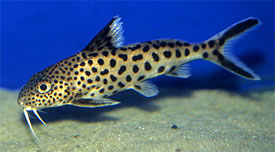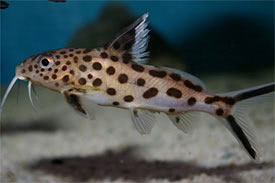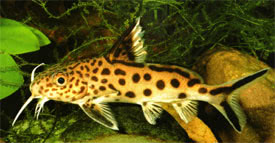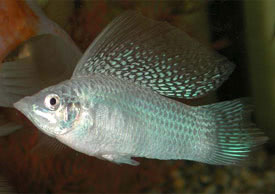
 Magyarul / Hungarian
Magyarul / Hungarian




- Scientific name : Synodontis multipunctatus
- Synonyms: Synodontis multipunctata
- Common name: Cuckoo Synodontis, Multi-spotted synodontis
- Group: Catfishes
- Habitat: Africa; West and Central African rivers, Lake Tanganyika.
- Size: 12 cm
- Biotope: Lake Tanganyika, tributaries of the Malagarasi river.
- Social behavior: They are generally a good community fish , but do not keep with fishes that are too small. Ideal companion for east African lake cichlids.
- Diet: Omnivore, tablet food, pellets, snails, live foods of all kinds.
- Breeding: Quite easy, but rare.
- Tank: Minimum 300 litres
- Population: 4-5 fishes for 500 litres.
- Decoration: Stone decoration with caves.
- Temperature: 24-28 °C
- pH: 7,5-8,5.
- Hardness: 11,2-19.6 NK°
- Lifespan: 10-15 years
Description: The body is deep, but by contrast the dorsal fin of typical specimens is fairly low. The low adipose fin begins some distance behind the dorsal fin. The caudal fin is deeply forked and has narrow lobes, moderately pointed at their tips. The base coloration of Synodontis multipunctata is whitish grey, becoming a stronger brownish colour, often a very attractive golden bronze, on the head and dorsum. The belly is whitish. On the base coloration there are roundish dark brown spots of variable size, at most eye diameter and smaller on the head. The paired fins and the dorsal and anal fins are brown to blackish on their anterior part, with a whitish margin posteriorly. The caudal-fin lobes are black-brown internally and again edged with white. An attractive and peaceful fish when young: 3-5 juveniles can be kept together. Adults are solitary fish but do not exhibit marked territorial behavior. As expected from its origin, the species likes hard water with a high proportion of carbonate hardness. Perhaps some salt should be added. When netting, one must be very careful of the spines on the pectoral fins which have serrated edges. These can become easily entangled in netting and may cause injury to the fish or hobbyist.
The reproduction of this catfish has made it one of the best-known species of the genus, and it is also known as the cuckoo catfish. It has been reported (from observations in the wild) that the eggs of Tanganyikan Synodontis species are taken up and incubated in the mouth of cichlids of the genus Haplochromis. Synodontis multipunctata is very similar to S. petricola but differs by the larger eye diameter, fewer and larger spots on the body and a shorter, rounder mouth.



















